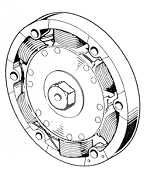|
Confirming the problem
In Part 1, we did all the preliminary stuff. Don’t make the mistake of viewing these preliminary steps as less important. You’re wasting your time if you don’t approach this scientifically. Now let’s confirm that we actually have a charging problem. Use your multimeter set for 10 DC amps. Start and idle the engine. Rev the engine to 5,000 rpm and read the meter. The result needs to be at least one-fourth of the battery’s amp/hour rating. The 12 a/h battery on many vintage Honda twins therefore should receive a minimum of 3 amps. Read the meter quickly. If you hold the engine at 5,000 rpm for more than a few seconds, the regulator will activate, throwing off the reading. So be quick.
Troubleshooting steps
(1) If the reading is less than one-fourth the battery’s a/h rating, bypass the regulator as described previously (in Part 1) and repeat the test. Rev to only 3500 rpm max to prevent headlight damage. If the result increases significantly, the regulator is the problem. (2) If the reading is still too low, inspect the charging system rotor two ways. First, test its magnetism. A screwdriver put against it should take some effort to remove again. It should grip tight. Next, remove the rotor holding bolt and confirm there is a key in the rotor’s keyway. Be sure to reinstall and torque the bolt afterward. (3) If no issue is found with the rotor, make sure all connections are reestablished, then disconnect the charging system stator and connect your 2 ohm/100 watt test resistor’s two outer lugs to the stator’s two output wires, and connect your multimeter set to AC Volts to the same two places. Again rev the engine to 5,000 rpm. The result should be a minimum of 14v. If that is the result, the rectifier is bad (you have already blessed the regulator). If that is not the result, the stator is bad. Replace the part indicated.
The breakeven test
Not all charging system problems are due to faults in the system. Some can be due to problems on the rest of the bike. You’ll see this when the problem confirmation (charge amps measurement) returns an indication of good charge, yet the battery, which has been eliminated as a (the) problem by charging and load-testing, is still being badly depleted when the bike is ridden. This calls for two special tests. First we’ll measure charging system breakeven, using your multimeter the same way as with the confirming-charge test. Start the engine and from an idle very slowly increase engine rpm until your multimeter reads exactly in-between discharge and charge—i.e., 0 amps. Note the rpm on the bike’s tachometer. The charging systems on all of Honda’s vintage permanent magnet systems should break even within a few hundred rpm of the idle rpm. Turn down the idle rpm below normal temporarily if needed to confirm this while doing the test. If breakeven occurs at say 2000 rpm, and the first stage of testing (Part 1) exonerated the system, this is a problem, and it means there is an incorrect balance between charge and discharge. Something is sucking down power. Maybe it’s an aftermarket headlight. Maybe the rear brake stop switch is misadjusted or malfunctioning—the brake light on these small bikes is enough to seriously impair charging if it stays on when it shouldn’t. Check other suspect things such as any accessories or electrical modifications. Temporarily undo them and see if the breakeven improves (the rpm at which it happens lowers).
The key-off drain test
If breakeven is instead good (more or less at idle and way below 2000 rpm), then we’ll measure the drain from the battery while the keyswitch is turned off. Set your multimeter up for measuring milliamps. That's abbreviated by "mA". Don't turn the key on. There should be no current reading—the meter should read 0. If you have a full-time accessory attached to the bike such as an iPhone or GPS or theft alarm or clock, you will get a reading such as 10mA, 20mA, possibly a little more. On the low-producing charging systems found on the early Honda twins, almost any key-off reading will quickly flatten the battery while it is parked, so we don’t want it. Remove the offending item and repeat the test to confirm it was the problem. If no accessory can be pinpointed as responsible, yet there is for sure a meter-verified key-off drain, then the problem is the rectifier, which is the only charging system part that is permanently electrically connected to the battery when the key is turned off. It is leaking current out of the battery. Back-flow is in fact one of the many faults of the early selenium-type rectifiers. Substitute another rectifier and retest key-off drain.
Part 3
|

 ®
®
